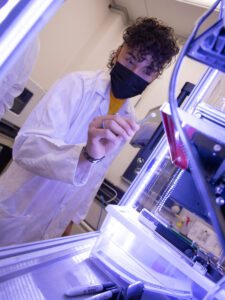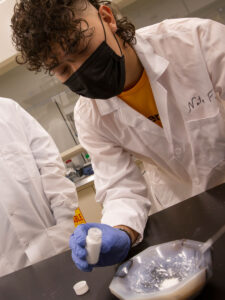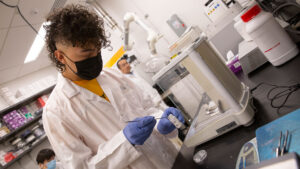Nathan Fonseca
Engineering (mechanical systems)
Hometown: San Tan Valley, Arizona, United States
Graduation date: Spring 2022
Additional details: First-generation college student

FURI | Spring 2022
3D-Printing Ceramic-Based Solid-State Electrolytes
The current lab production of Solid-State Electrolyte (SSE) for lithium-ion batteries is limited to planar geometries and random porosities. Although SSE has shown improvements, it still faces dendrite propagation issues. Additive manufacturing, known for its rapid prototyping, enables the materials and hierarchies to be modified to mechanically avert dendrite propagation and prevent further degradation of batteries. Finding an ideal patterning configuration to efficiently block the dendrite growth while maintaining a safe, high-energy-density solid-state is our ultimate goal. Therefore, studies will be tailored into bridging the gap between laboratory studies and commercialization via additive manufacturing technologies.
Mentor: Kenan Song
Featured project | Spring 2022
Mechanical systems engineering senior Nathan Fonseca is exploring additive manufacturing techniques to prevent degradation in solid-state lithium-ion batteries in a FURI project with Assistant Professor Kenan Song. Fonseca got involved in FURI for the opportunity to work on a sustainability-related project and because he wanted to present his findings.
What made you want to get involved in FURI? Why did you choose the project you’re working on?
I joined FURI to further enhance my research curriculum while representing holistic development in diversity. My motivation for this project came from previously working with the Summer Research Internship program where I developed conventional solid-state electrolytes for lithium-ion batteries. However, the process required multiple steps, and the design was constrained to basic geometries and random porosities. This led me to switch from the conventional method of cold pressing pellets to additive manufacturing methods, which are more effective.
How will your research project impact the world?
My project focuses on creating a safer battery via 3D printing. Researchers in this field know that the propagation of dendrites (branching crystalline structures) is one of the main problems that lithium-ion batteries face. Oftentimes, dendrite penetration leads to batteries degrading or internally becoming explosive. Therefore, by studying the effects of different hierarchies designs via 3D printing can help mechanically suppress dendrite propagation. This in effect will lead to a more sustainable and degradable battery with high safety characteristics. Furthermore, by validating its higher safety factor, the promotion to bridge lab production to industrial commercialization will have a higher impact on the battery world.
Have there been any surprises in your research?
3D printing ceramic-based resins is a challenge due to their higher viscosity, brittleness and higher temperature. Furthermore, the connection between powder and slurry for printing was a challenge. I knew that the community of ceramic 3D printing is relatively new as compared to polymers or metals. However, through substantial reading and research, I learned that introducing binders and polymers into the ceramic powders change the powders into a slurry consistency. The amount of binders introduced had a direct effect on the printability giving a higher self-supporting ink. With this in mind, I worked with other lab mates to tweak the direct ink writing machine where the nozzle would not get clogged and a smooth ink was produced.
What has been your most memorable experience as a FURI student researcher?
As a student researcher, the most memorable experience was being able to go to the Spring 2022 American Chemical Society meeting with all of my lab mates and share our results, learn from leading researchers on state-of-the-art projects and support one another on our symposium presentations. We also did multiple team-building activities and learned a lot from one another.
How do you see this experience helping with your advanced degree goals?
My “aha!” moment during this project was realizing that I want to continue my graduate school and keep cherishing memorable moments such the ones at the American Chemical Society meeting.
As I pursue my doctoral degree, FURI has allowed me to connect with many faculty members and learn from them. I have come to the realization that I want to be someone that promotes the holistic development of minorities. My end goal is to continue to develop groundbreaking technologies where the diversity of color, culture, background and many other factors does not matter, but the harmonious goal to positively impact our society and play a major role in the world do.
What is the best advice you’ve gotten from your faculty mentor?
Keep a humble heart and cherish the relationships built.
Why should other students get involved in FURI?
It is a great opportunity to learn about groundbreaking technologies and be part of a greater cause. Being able to get hands-on research experience is tremendously valuable — theories learned in classrooms are applied and the connection between theory and reality give any student a deeper, more intimate understanding. I’m also looking forward to joining the Master’s Opportunity for Research and Engineering program next semester.


